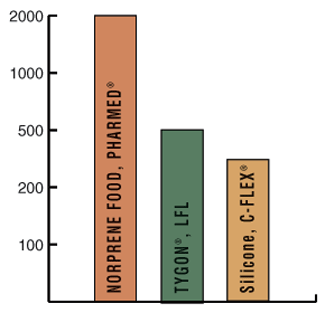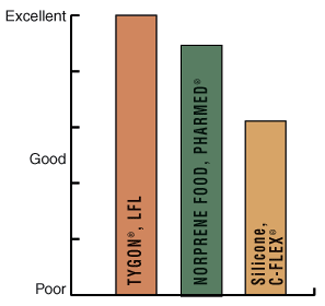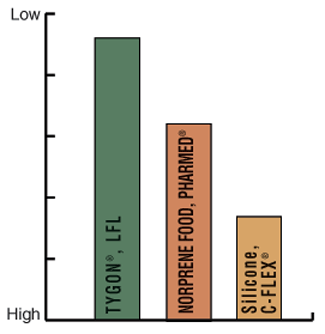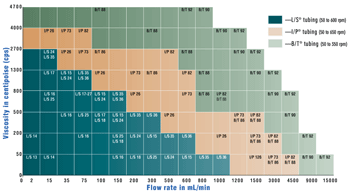Masterflex® B/T® Precision Pump Tubing
Ensure top performance with your Masterflex pump head by using precision-extruded Masterflex tubing to deliver accurate flow rates. Thirteen different material formulations are available.
To order the correct tubing:
- Consider all the aspects of your application: flow rate, pressure, etc.
- Review the Chemical Compatibility data, as well as specific information about individual tubing materials.
- Use the Tubing Material Life Comparison graph and Tubing Selection Guide for Pumping Viscous Fluids table to select the tubing with the longest life.
If your application requires the generation of high pressure or a strong vacuum/ suction lift, refer to the Pressure Guidelines and Vacuum/Suction Lift graphs below. These graphs can assist you in determining which tubing will pressurize most rapidly or develop the strongest vacuum/suction lift in your application.
If your application requires pumping air-sensitive gases or liquids, refer to the Gas Permeability graph below to choose the tubing with the lowest permeability.
If you are pumping a viscous fluid, refer to Tubing Selection Guide for Pumping Viscous Fluids to select the best tubing size.
Tubing Life Comparisons

The graph above displays the average tubing life in hours of Masterflex B/T® 90 tubing. This tubing was tested in a Masterflex Standard pump head continuously pumping water at 21°C (70°F) and 0 bar (0 psig). Tubing life is calculated to time of failure or of 50% reduction in flow rate, whichever comes first. Reduce drive speeds to extend tubing life. Average tubing life for L/S 16, I/P 73, and B/T 90 tubing at various rpm are listed in the table below.
| Tubing class | L/S® | I/P® | B/T® | |||
|---|---|---|---|---|---|---|
| Drive rpm | 50 | 600 | 50 | 600 | 50 | 350 |
| NORPRENE® PHARMED® | 10,000 | 1000 | 4000 | 800 | 2000 | 400 |
| TYGON® LFL | 1000 | 500 | 800 | 400 | 500 | 130 |
| Silicone C-FLEX® | 500 | 100 | 400 | 80 | 250 | 100 |
| TYGON® | 200 | 50 | 180 | 35 | 100 | 30 |
| VITON® | 150 | 30 | 120 | 25 | | |
Pressure Guidelines

All tubing types accept pressure, but the firmer formulations accept more pressure than the softer types of tubing.
Vacuum/Suction Lift

Vacuum/suction lift capability depends greatly on the tubing's ability to maintain its shape. Thus, a firmer tubing type in the smallest possible bore size will generate a stronger vacuum for your application. Higher drive speeds are required to generate the strongest possible vacuum with some tubing sizes.
Gas Permeability

To minimize permeation of gases through the tubing wall, use firm tubing. Masterflex B/T High-performance precision tubing (B/T® 86, and B/T® 90) is less permeable than Precision tubing sizes.
Pumping Viscous Fluids
To maximize the pumping efficiency of viscous fluid, follow these steps.
- Slow down the speed of your pump. Increasing the speed beyond a certain point will not have any effect on flow rate. The maximum efficient speed of the pump decreases as viscosity increases and tubing size decreases.
- Choose a larger size tubing than required to pump water. The table below will help you choose the best size.
- Choose a firm tubing such as NORPRENE, PHARMED, VITON, or TYGON LFL. Performance will be better because the tubing returns to its original shape quickly after pump head occlusion. Choose B/T precision tubingthe thicker wall also returns more quickly to its original shape than Precision tubing. The quicker return allows liquid to be pulled into the tubing with greater force.
- Select a tubing with a smooth bore. A smooth bore will decrease frictional forces. TYGON, TYGON LFL, silicone, or the new TYGON silicone formulation are good choices.
- Decrease the viscosity of your fluid. Heat your fluid if possible; viscosity usually decreases with temperature.
Tubing Selection Guide for Pumping Viscous Fluids

How to Use this Graph
Example: You have a 2700 centipoise fluid that you wish to pump at 1200 mL/min. Find 1200 mL/min on the "flow rate" axis of the graph above and find 2700 centipoise on the "viscosity" axis. Follow the two points to where they meet. The graph shows that B/T® 90 tubing will produce the desired flow rate. These tubing sizes will also work for all lower viscosities and lower flow rates.
Considerations: All viscosity test data was obtained using firm tubing materials such as NORPRENE, PHARMED, VITON, and TYGON because these formulations perform the best in high viscosity applications. Tests were performed with fluids at 21°C (0°F) and 0 bar (0 psig) of back pressure. The graph is best used as a general guideline only, and is not a guarantee that you will achieve the results shown.
Last Updated: 11/30/21